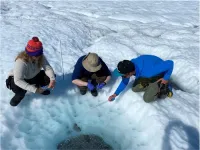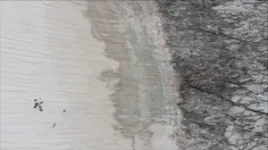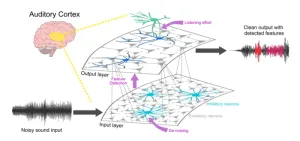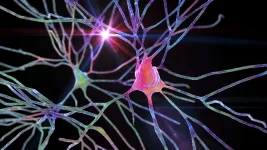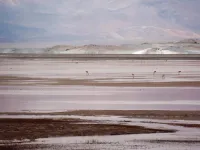(Press-News.org) There are no plants, and only very few animals: people rarely come here. The large glaciers in Greenland have long been perceived as ice deserts. Gigantic ice sheets where conditions for life are extremely harsh.
But now, it seems, we have been wrong. There is much more life on the glaciers than we thought.
Headed by Professor Alexandre Anesio, a group of researchers from the Department of Environmental Science at Aarhus University have discovered that the glaciers are teeming with life. Microbes that have adapted to life on the ice. And not just one or two species. Several thousand different species.
“A small puddle of melt-water on a glacier can easily have 4,000 different species living in it. They live on bacteria, algae, viruses and microscopic fungi. It’s a whole ecosystem that we never knew existed until recently," says Alexandre Anesio.
What do the microbes live on?
Over the past 50 years, researchers have repeatedly been surprised by the hardiness of life. Life has been found several kilometres underground – where there is neither sun nor oxygen. Billions of microorganisms "eat" minerals in the bedrock and so can survive.
Researchers have shown that life can even survive in space. In 2007, European researchers placed a colony of more than 3,000 microscopic water bears (tardigrades) outside a satellite and sent them into orbit around the Earth. The orbit lasted 10 days, after which the satellite returned to Earth. No less than 68 per cent of the microbes survived the vacuum of space and the lethal radiation.
Therefore, it might not come as a surprise that life also thrives on the glaciers. After all there is sun, oxygen and water. Nevertheless, until recently, researchers believed that the ice had too little nourishment to sustain life. But they were wrong.
There is nourishment. Just in incredibly small quantities, explains Alexandre Anesio.
Black algae
One of the microorganisms on the ice that the researchers spent most time investigating is a small black algae. The algae grows on top of the ice and tinges it black. There is a reason why the black algae so interesting for the researchers.
“When the ice darkens, it becomes more difficult to reflect sunlight. Instead, heat from the sun's rays is absorbed by the ice, which starts to melt. The more the ice melts, the warmer the temperature on Earth. The algae therefore play an important role in global warming," says Alexandre Anesio.
In recent years, larger and larger areas of the ice have become stained by the algae, making the ice melt even faster. Alexandre Anesio has calculated that the algae are increasing the ice melt by about 20 per cent.
The algae on the ice also existed before people kicked off global warming through industrialisation. However, climate change means spring arrives ever earlier to the Arctic and as a result the algae have a longer season to grow and spread.
"The algae spread a little more every year. When I travel to Greenland, I now see vast areas where the ice is completely dark because of the algae,” he says.
Looking for an algaecide
Alexandre Anesio and his colleagues are spending a lot of time on the black algae because they are trying to find out whether the algae growth can be slowed down in some way or another.
The is a balance In most ecosystems - a kind of equilibrium - because the various organisms keep each other in check. So Alexandre Anesio wants to learn more about the relationship between the different microbes.
“The various microorganisms on the ice affect each other. Some leave nutrition that others live off. Small viral particles attack and consume bacteria. We believe that some of the fungal spores could eat the black algae. This is what we're looking for,” he says.
However, he stresses that, even if they do find a way to curb algae growth, this will not solve climate change. Although it could slow it down.
Algae growth is a consequence of our releasing too many greenhouse gases into the atmosphere. And this is where the problem must be solved. We need to focus on slowing down our emissions.
The same pigment as in black tea
Algae is found virtually everywhere. In the sea, in lakes, on trees and rocks, and even as small spores in the air. Most algae are greenish. Like plants and trees, they are green because of chlorophyll. A molecule that enables them to photosynthesise.
But it's different for the black algae.
"Because the algae live on the ice, they’re bombarded with sunlight and radiation. To protect themselves, they produce a lot of black pigment. It’s actually the same pigment as in black tea. The pigment forms a protective layer outside the algae and protects the chlorophyll molecules against the dangerous radiation," says Alexandre Anesio.
When the pigment absorbs the sun's rays, it generates heat. This heat makes the ice around the algae melt. And this actually benefits the algae. They need both water and micronutrients from the ice to live.
And they can only use the water when it is liquid.
NASA also has an eye on his research
Alexandre Anesio’s research into life on the ice is important for a better understanding of climate change. However, NASA is also following his research results closely. The results may be crucial in the hunt for life in space.
"NASA has approached us several times because we‘re working with life that lives in one of the most inhospitable places on Earth. If life thrives on and under the ice, there’s a probability that we’ll also find life in the ice on Mars or Jupiter's and Saturn's ice moons, for example,” he says.
Before NASA sent their Perseverance rover to Mars, they even invited Alexandre Anesio to a meeting.
“They were afraid that the rover would take with it microbes from Earth. Microbes that may be able to survive on Mars and pollute the samples they were going to take from Mars. So, they wanted to know what conditions life can survive in. What are the boundaries for life?”
Can give an indication of what they should look for
NASA is so interested in the research of life in the ice because we haven’t found liquid water on any other planets in the solar system. Not yet, anyway. But we've found plenty of ice.
However, there is evidence to suggest that there are liquid oceans beneath the frozen surface of Saturn’s moon, Enceladus and Jupiter's moon, Europa – and one of the necessities of life, as we know it, is liquid water.
Therefore, NASA and other space agencies are very interested in learning more about the type of life that can live on and under the ice. Because organisms that resemble those in Greenland are probably those they’ll be looking for on the ice moons.
"Like us, they’re very interested in how the microorganisms on the ice function. How much nutrition do they need? What type of nutrition? And how does the ecosystem they are part of work? These are questions that we hope to be able to answer in the future," says Alexandre Anesio.
END
Researchers discover that the ice cap is teeming with microorganisms
Greenlandic ice is teeming with life, both on the surface and underneath. There are microscopic organisms that until recently science had no idea existed. There is even evidence to suggest that the tiny creatures colour the ice and make it melt faster.
2023-05-02
ELSE PRESS RELEASES FROM THIS DATE:
Behavior patterns of people who achieve clinically significant weight loss
2023-05-02
COLUMBUS, Ohio – A new study analyzing data on over 20,000 U.S. adults links a healthier diet and increased exercise to weight loss that reduces heart disease risk – while associating skipping meals and taking prescription diet pills with minimal weight loss, weight maintenance or weight gain.
For many in the study sample, however, losing a “clinically significant” 5% of their body weight did not eliminate their risk factors for cardiovascular disease, results showed. In fact, the average ...
Accelerating coral reef science: building consensus around the assessment and interpretation of Symbiodiniaceae diversity
2023-05-02
New research published in PeerJ Life and Environment by Dr. Sarah Davis and sixty-one scientists from 12 countries presents a perspective to build consensus around the assessment and interpretation of Symbiodiniaceae diversity. Symbiodiniaceae is a family of marine dinoflagellates (plankton) notable for their symbiotic associations with reef-building corals, sea anemones, jellyfish, marine sponges and other marine invertebrates. Understanding Symbiodiniaceae is important to those working to protect and regenerate coral reefs that are under threat around the world.
"The authors hope this paper will provide a springboard to launch ...
The International World Wide Web Conference selects Seoul Test of Time Award
2023-05-02
The International World Wide Web Conference Committee (IW3C2) announced today that the 2023 Seoul Test of Time Award will be presented to the authors of the paper “A Contextual-Bandit Approach to Personalized News Article Recommendation;” Wei Chu, (Ant Group), Lihong Li, (Amazon), John Langford, (Microsoft) and Robert Schapire (Microsoft).
The award will be presented during the opening ceremony of the 32nd international conference in The ACM Web Conference series (formerly known as The International World Wide Web Conference) hosted by the team in Austin. See https://www2023.thewebconf.org ...
60 years later, high school quality may have a long-term impact on cognition
2023-05-02
NEW YORK, NY (May 2, 2023)--A study of more than 2,200 adults who attended U.S. high schools in the early 1960s found that those who attended higher quality schools had better cognitive function 60 years later.
Previous studies have found that the number of years spent in school correlates with cognition later in life, but few studies have examined the impact of educational quality.
“Our study establishes a link between high-quality education and better late-life cognition and suggests that increased investment ...
Too much water can make whiskies taste the same
2023-05-02
RICHLAND, Wash. – While adding a little water is popularly thought to “open up” the flavor of whisky, a Washington State University-led study indicates there’s a point at which it becomes too much: about 20%.
Researchers chemically analyzed how volatile compounds in a set of 25 whiskies responded to the addition of water, including bourbons, ryes, Irish whiskeys and both single malt and blended Scotches. They also had a trained sensory panel assess six of those whiskies, three Scotches and ...
Machine learning model sheds light on how brains recognize communication sounds
2023-05-02
PITTSBURGH, May 2, 2023 — In a paper published today in Communications Biology, auditory neuroscientists at the University of Pittsburgh describe a machine learning model that helps explain how the brain recognizes the meaning of communication sounds, such as animal calls or spoken words.
The algorithm described in the study models how social animals, including marmoset monkeys and guinea pigs, use sound-processing networks in their brain to distinguish between sound categories – such as calls for mating, food or danger — and act on them.
The study is an important step toward understanding the intricacies and complexities ...
Cellular “cruise control” system safeguards RNA levels in Rett syndrome nerve cells
2023-05-02
Every cell in our body is able to turn genes (DNA) on or off, producing RNA, but when genes are ‘turned on’ to the wrong level it can result in a variety of health conditions.
Rett syndrome is a rare neurodevelopmental condition that causes a loss of motor and language skills over time in girls. The condition is caused by a genetic variation in the MECP2 gene located on the X chromosome, resulting in affected nerve cells in the brain expressing the wrong levels of more than one thousand genes. The end result is that Rett syndrome nerve cells are smaller, less interconnected and less electrically active than healthy controls.
In ...
Study finds gender pay differences begin early, with the job search
2023-05-02
A new paper in the Quarterly Journal of Economics, published by Oxford University Press, indicates that an important part of the pay gap between men and women has to do with how they conduct job searches, with women more likely to accept job offers early while men tend to hold out for higher pay.
Women in the United States earn 84% of what men earn, as of 2020. This disparity is well documented, and economists and the general public have known about the earnings difference for decades. The reasons for this phenomenon are a matter of considerable debate.
Initial conditions in the labor market are long-lasting. Young workers who begin ...
Single-molecule valve: a breakthrough in nanoscale control
2023-05-02
Scientists dream of using tiny molecules as building blocks to construct things, similar to how we build things with mechanical parts. However, molecules are incredibly small - around one hundred millionth the size of a softball - and they move randomly in liquids, making it very difficult to manipulate them in a single form. To overcome this challenge, “nanofluidic devices” that can transport molecules in extremely narrow channels, similar in size to one millionth of a straw, are attracting attention ...
The science behind the life and times of the Earth’s salt flats
2023-05-02
AMHERST, Mass. – Researchers at the University of Massachusetts Amherst and the University of Alaska Anchorage are the first to characterize two different types of surface water in the hyperarid salars—or salt flats—that contain much of the world’s lithium deposits. This new characterization represents a leap forward in understanding how water moves through such basins, and will be key to minimizing the environmental impact on such sensitive, critical habitats.
“You can’t protect the salars if you don’t first understand how they work,” says Sarah McKnight, lead author of the research that appeared recently ...
LAST 30 PRESS RELEASES:
URI researchers uncover molecular mechanisms behind speciation in corals
Chitin based carbon aerogel offers a cleaner way to store thermal energy
Tracing hidden sources of nitrate pollution in rapidly changing rural urban landscapes
Viruses on plastic pollution may quietly accelerate the spread of antibiotic resistance
Three UH Rainbow Babies & Children’s faculty elected to prestigious American Pediatric Society
Tunnel resilience models unveiled to aid post-earthquake recovery
Satellite communication systems: the future of 5G/6G connectivity
Space computing power networks: a new frontier for satellite technologies
Experiments advance potential of protein that makes hydrogen sulfide as a therapeutic target for Alzheimer’s disease
Examining private equity’s role in fertility care
Current Molecular Pharmacology achieves a landmark: real-time CiteScore advances to 7.2
Skeletal muscle epigenetic clocks developed using postmortem tissue from an Asian population
Estimating unemployment rates with social media data
Climate policies can backfire by eroding “green” values, study finds
Too much screen time too soon? A*STAR study links infant screen exposure to brain changes and teen anxiety
Global psychiatry mourns Professor Dan Stein, visionary who transformed mental health science across Africa and beyond
KIST develops eco-friendly palladium recovery technology to safeguard resource security
Statins significantly reduce mortality risk for adults with diabetes, regardless of cardiovascular risk
Brain immune cells may drive more damage in females than males with Alzheimer’s
Evidence-based recommendations empower clinicians to manage epilepsy in pregnancy
Fungus turns bark beetles’ defenses against them
There are new antivirals being tested for herpesviruses. Scientists now know how they work
CDI scientist, colleagues author review of global burden of fungus Candida auris
How does stroke influence speech comprehension?
B cells transiently unlock their plasticity, risking lymphoma development
Advanced AI dodel predicts spoken language outcomes in deaf children after cochlear implants
Multimodal imaging-based cerebral blood flow prediction model development in simulated microgravity
Accelerated streaming subgraph matching framework is faster, more robust, and scalable
Gestational diabetes rose every year in the US since 2016
OHSU researchers find breast cancer drug boosts leukemia treatment
[Press-News.org] Researchers discover that the ice cap is teeming with microorganismsGreenlandic ice is teeming with life, both on the surface and underneath. There are microscopic organisms that until recently science had no idea existed. There is even evidence to suggest that the tiny creatures colour the ice and make it melt faster.
